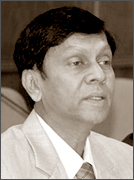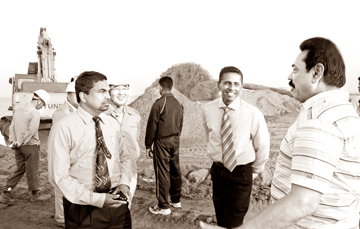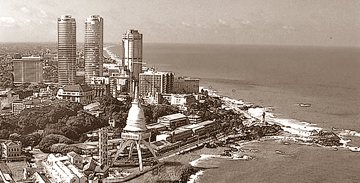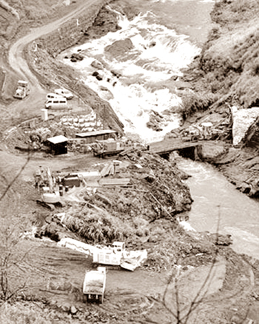Year 2010, a promising year - CB Governor
by Shirajiv SIRIMANE
|

Ajith Nivard Cabraal
|
|

The President visiting the site of the Colombo South Harbour
|
Prudent economic management by the government paid rich dividends as
the country was able to record a 3.5 percent economic growth last year.
This is a commendable achievement given the fact that many countries
recorded a negative or low economy growth in 2009.
This was mainly due to the global economic downturn. For Sri Lanka,
in addition to the war, high crude oil prices also had a negative impact
on the economic growth in the first six months of last year.
However, with the global economy showing signs of recovery and Sri
Lanka minus the burden of fighting a war, signs are clear that the Sri
Lankan economy is gradually recovering from the impact.Despite the
global economic downturn the banking industry performed well last year.
The Central Bank has pursued strict regulation on the banking sector
during the global economic meltdown. As a result there was not much
impact on the banking sector of the country.
"The 2010 is a very promising year as we are now in a completely
different platform with the ending of nearly three-decade conflict,"
said the Governor of the Central Bank Ajith Nivard Cabraal.
He said that the Sri Lankan economy grew by 6 per cent or over during
the 2006-2008 period. This growth momentum slowed down in 2009 to a
certain extent. "Yet, we believe that the economy has grown by 3.5
percent during last year," he said.
Q: What are your predictions for 2010?
|

The Colombo city |
A: The macroeconomic fundamentals are at a healthy position
right now and there is a very conducive environment to grow at a faster
rate. Inflation is at historically low levels. Interest rates are also
low creating a conducive environment to enhance private sector
activities. Foreign reserves, another major issue that we faced in early
2009, are at historically highest levels. Infrastructure bottlenecks are
being addressed with the implementation of mega infrastructure
development projects including roads, highways, ports and airports. The
global economy is gradually recovering from the most severe crisis after
the World War II, which will provide strong impetus to the domestic
economy in 2010 and beyond by creating tremendous opportunities for us.
Economic activities in the North and the East are reviving gradually.
There is no threat of insecurity, a vital factor to make investment
decisions.
So, with all these developments, we expect that the pre-recession
growth momentum in the Sri Lankan economy will be easily achieved in
this year by recording a growth rate of above 6 percent. Once we take
off from this base, the upswing will continue at a faster rate. We know
that we have to work hard to sustain this higher growth path. That's why
I always emphasise the fact that we need to carefully monitor this
process and take appropriate decisions, and be focused and determined to
fast track this process.
Q: How would Sri Lanka minus a GSP plus survive?
A:The Duty free export concessions availed by the GSP+ scheme
has helped to increase market share of Sri Lankan exports in the EU in
recent years. Overall, the value of the benefit to the buyers in the
European Union under the GSP+ concessions from the Duty waiver on the
7,200 items was approximately Euro 78 million in 2008. This amounts to
about 1.8 percent of total exports (US dollars 8,137 million) and 4.9
percent of total exports to the European Union (US dollars 3034 million)
in 2008.
The effect could be negated to some extent by adopting measures to
enhance the productivity of the exporters by increasing the efficiency
of the production process, upgrading technology, and reducing costs and
waste, in order to retain or enhance their competitiveness. It would
also propel them to diversify their range of products, and would make
them search for new markets, which may make Sri Lanka's exports more
competitive in the long run.
|

Work on the Upper Kotmalle project in progress |
It is also necessary to reduce Sri Lanka's dependence on
non-reciprocal trade arrangements. In the meantime, the government had
provided an assurance that it will deal with any fall-out in the event
the GSP+ is suddenly withdrawn. The government also could assist these
efforts by finding new markets, developing infrastructure, improving the
investment climate, and ensuring adherence to standards, laws and
regulations.
Q: Sri Lanka's per capita income is now over USD 2,000 and
unemployment too is reducing. Your comments.
A: In 2004, the per capita income in Sri Lanka was USD 1,062,
which was increased to USD 2,014 by 2008. The strong economic
performance in recent years assisted in lifting the per capita income
well above USD 2,000 level and helped in graduating Sri Lanka to the
category of middle income emerging market status from January, 11, 2010
by the IMF. The per capita income has been targeted at USD 3,000 by 2011
while USD 4,000 has been targeted to be achieved by 2014. The positive
impact of the end of the conflict will be strongly supportive of
achieving these targets.
The unemployment rate, which was 5.2 percent in 2008, was 5.8 percent
by the third quarter of 2009. The continuous decline observed in the
unemployment rate in Sri Lanka from 2002 onwards slightly increased in
the third quarter of 2009 due to the impact of the global economic
recession. However, this negative situation has recovered with the
recovery in the global economy.
The continuous decline in the unemployment rate is mainly due to the
increased recruitment in the public sector, increased foreign employment
opportunities, expansion in the domestic economy, domestic production
and increased new economic activities in the North and the East.
Q: Inflation after 15 years has reached a single digit. What
was the success formula for this?
A: The annual average inflation rate decelerated steadily to
3.4 percent by December 2009, which is the lowest annual average
inflation rate recorded since 1985. The steady deceleration in the
annual average inflation rate was a result of favourable developments in
both the demand and supply side factors. On the demand side, the tight
monetary policy pursued by the Central Bank in 2007 and 2008 effectively
checked rising inflation. On the supply side, favourable domestic supply
conditions, mainly from the North and the East and the decline in
international commodity prices, lowered price pressures.
Q: President has promised a salary increment of Rs. 2,500 for
the State sector? Is this possible?
A: We know that the total number of government employees of
our country, excluding government corporations and other statutory
boards, is about 1.04 million. Hence, the total annual cost to provide
Rs. 2,500 salary increase would be about Rs. 31 billion.
To provide such an increase, the government will either have to have
savings from other recurrent expenditures or there has to be a
considerable increase in government revenue as the government is
committed to increase investment expenditure. Of course, there are many
recurrent expenditure items that cannot be reduced, particularly
interest, salaries, pensions, and welfare payments. Then, the other most
appropriate alternative would be to generate enough revenue to meet
these expenses.
I mentioned at the beginning that the economy is projected to grow at
a rate of over 6 percent in 2010, which would generate higher amount of
revenue through the enhanced domestic economic activities as well as
international trade, thereby offsetting the cost of the proposed salary
increase.
Q: Your comments on foreign exchange reserves and trade
deficit?
A: Gross official reserves, excluding ACU receipts, recorded
the historically highest level of US dollars 5.1 billion by end 2009.
There is no need to say that we got a huge boost to the economy with the
end of the conflict in May 2009. Investors were very bullish and those
who left us during the crisis, returned with renewed confidence. Why?
Because, Sri Lanka honoured all the due payments for them. We did not
default even a cent. Not only the investors, the IMF also endorsed our
policies and approved a Standby Arrangement in July 2009. They have
endorsed the economic management of the country too.
These are the positive results of the ending of the conflict and
enhanced prospects of the country. Our exporters also brought their
forex into the country, we got a very significant amount of foreign
remittances, and IMF also provided us with general and special
allocation of SDRs. All these factors helped increase our gross official
reserves. The level of reserves that we have now is equivalent to 6.2
months of imports. So, now we are in a strong footing to face future
challenges. In fact, with the expected higher inflows on account of
workers remittances and financial inflows to the government and private
sector including foreign direct investments, foreign exchange reserves
are expected to increase further in 2010.
Regarding the trade deficit, you know that it has narrowed
considerably in 2009. In fact, on a year-on-year basis, cumulative
earnings from exports and expenditure on imports declined by 14.7
percent and 31.9 percent, respectively during the first eleven months of
2009.
The decline in imports is mainly due to the lower expenditure on
intermediate goods, including petroleum. With the revival of economic
activities, the imports will pick up. The exports have declined due to
the lower international demand.
However, in the recent months, we have seen some recovery in exports,
which will be expedited with the recovery of the global economy. The
cumulative trade deficit decreased by 55.1 percent to US Dollars 2,468
million during the first eleven months of 2009 from US Dollars 5,503
million in the corresponding period of 2008.
Q: How do you review Sri Lanka's foreign aid utilization?
A: Obtaining foreign resources is not a new policy in the
economic activities. Successive governments have resorted to foreign
funds for the continuation of development projects. Many of these loans
are on concessional basis.
In the recent past, usage of foreign resources has increased to
finance ongoing infrastructure projects such as the Southern Transport
Development Project, Power Sector Development Projects, the Kandy Water
Supply Project, the Southern Highway Development Project, the Upper
Kothmale Hydro Power Project, the Provincial Road Improvement Project,
the Puttalam Coal Power Project, Regional Bridge Projects, the
North-East Housing Construction Project, Road Sector Assistance Project,
The Supply and Construction of Pre-Fabricated Metal Bridges, the Colombo
South Harbour Project and the Oluvil Port Development Project.
|

